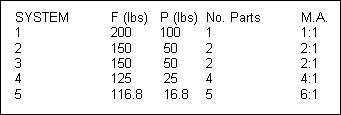
-
Most loads that are lifted are handled by pulley systems of some kind. For example, block and tackle or the reeving of the point sheaves and load block on a lift crane. This quiz is given to help the rigger get a better feel for "parts of line" and "mechanical advantage".
Parts of line are the number of lines supporting the load block and the load. For example, make an imaginary horizontal cut just above the load block in system 2 and count only the wires below the cut. There are two "parts" of wire in this example.
Mechanical advantage is a ratio of the output force to the input force. In the above quiz, it is assumed that the systems are frictionless and in equilibrium. Therefore, the M.A. is a ratio of the load and a force required to keep the system in equilibrium and = W/P.
Some comments on the quiz:
1. The left pulley in system 2 is just a diverter sheave for changing the direction of the wire rope and contributes nothing to the mechanical advantage. The down side is that the use of diverter sheaves does increase the lead line pull required to raise or move the load.
2. If the load "W" in system 2 must be raised, a force greater than "P" would be required due to the additional force required to bend the wire rope around both the sheave hooked to the support at the top, the sheave in the traveling block, the diverter sheave and the additional force required to overcome friction between all sheaves and their axles.
3. In a single pulley system ( one comprised of one wire rope) the M.A. and the number of parts of line are always the same. Therefore, P = W/No. of Parts
4. System 5 shows are double pulley system. Multiply the number of parts in each system to get the M.A. Note that there are two traveling blocks in this system. Therefore, the M.A. of system 5 = 2*3 = 6.
5. The force "F" shown in the quiz is the force required to support only those pulleys and their loads that are hooked to the support structure.
Note that if the load "W" in system 1 was a deer about to be strung up and dressed out, that a tree with a branch strong enough to support 200 lbs would have to be located. Also note that if a pulley arrangement similar to that shown for systems 2, 3, 4 or 5 were used that only a branch strong enough to support 150, 150, 125 and 116.8 lbs respectively would be required.
Maximum Reach Enterprises